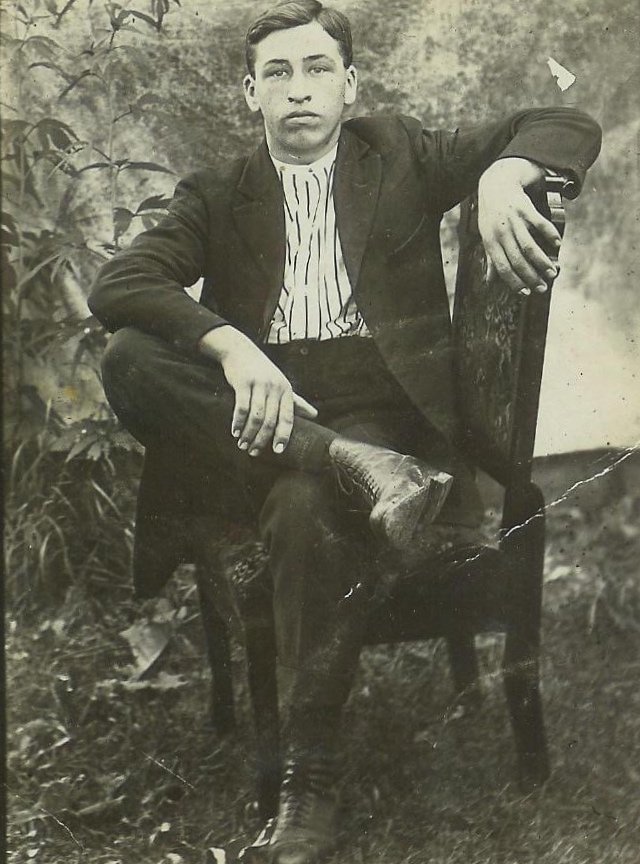The Hamilton County Historian maintains a modest collection of historic artifacts, mainly photographs, which are useful in the preservation, interpretation, and promotion of Hamilton County History. These are the resources that allow me to keep Hamilton County History alive on the web, on paper, in exhibits and presentations.
Most of these items are donated to my office by local families, seeking not only to preserve but share their family legacies with a broader public. Some arrive at the office in reasonably good shape; others are in urgent need of conservation measures; all require proper housing, storage and handling to protect them from corrosion due to inappropriate exposure to light, heat, humidity, mold and insects. Many, such as the image above, are unlabelled, and I'll address the process of identifying family heirlooms in another post.
This post is about material preservation. It can be a daunting task. If you're anything like me, you've probably faced the prospect of cleaning out a trunk, a closet, an attic, or an entire house upon the passing of an elderly relative, and started out with the best of intentions: organize, digitize and safely store the family collection. And like me, you've probably thrown your hands up in despair when you realize you are not a museum, and are not in possession of the tools, the time or the treasury to handle the task.
The last matter is no joke. A quick look at any archival materials catalog will tell you that historic preservation is big business. A simple archival document case can cost you ten bucks a pop, and if grandma was a collector, you could be looking at a considerable sum to house the whole kit and caboodle. But how could you store her precious memories in anything less than lignin-free, PAT-approved, archival-quality housing worthy of the Guggenheim? Guilt is built into the hard sell, and so is intimidation. If you don't know what PAT-approved means, then you must need to spend several years obtaining a degree in document preservation to figure it out before you begin.
All of this adds up to one thing: procrastination. And fair cop, I'm guilty of it myself. Late last year, I cleaned out the office with the intention of carrying on the good work my predecessor, Bill Zullo, had begun: accessioning the disorganized bits of the collection into some semblance of respectability. I had big plans: folders, boxes, labels, and a proper catalog (there isn't one, which is why it takes me ten times longer than it should to look stuff up when someone poses a question on the Facebook page). And then I won a grant, and then the Bicentennial loomed, and then another grant opportunity (or three) came up, and here I am, lecturing all of you about getting down to business with the family photos when the County collection needs my attention.
So I'm going to put my money where my mouth is. The fact is, there will always be something else to do. Next year will mark the centennial of women's suffrage in New York State, a great opportunity to do some research on the history of suffrage in Hamilton County. In 2018, the Town of Hope will mark its Bicentennial, and I'm planning to help Hope Town Historian Harry Downing prepare for a commemoration. There will be grant results to write up. If I don't make a start now, it's not going to happen.
On Friday afternoons, I'm going to take a break from the Bicentennial, the grant and everything else, and work on a box. Just one box, for just one hour. I have a box in mind. Going by the top layer, it's full of Camp of the Woods photos, and there may well be some Teffts in there. The box was here when I took the job in January 2014 so I don't know where it came from, but it's a jumble of treasure on Speculator history. I invite readers to join me. Pick a box, pick an hour, make a start, and let me know how it goes.
I'll be learning along with you. I'm a trained anthropologist but not the museum sort, so I'll be sorting the wheat from the chaff when it comes to the multitude of available advice. I've posted some promising links below to get us started. Homework for next week: grab a box and clear a space (you're going to need it).
National Archives:
How to Preserve Family Papers and Photographs
New York Times:
Tips on Archiving Family History, Part 1 (Audio)
Tips on Archiving Family History, Part 2 (Film & Photos)
Tips on Archiving Family History, Part 3 (Manuscripts & Video)
Northeast Document Conservation Center:
Caring for Private & Family Collections
Ask NEDCC

